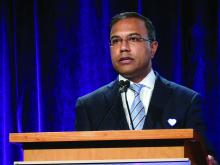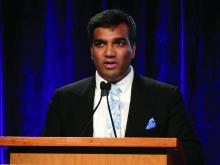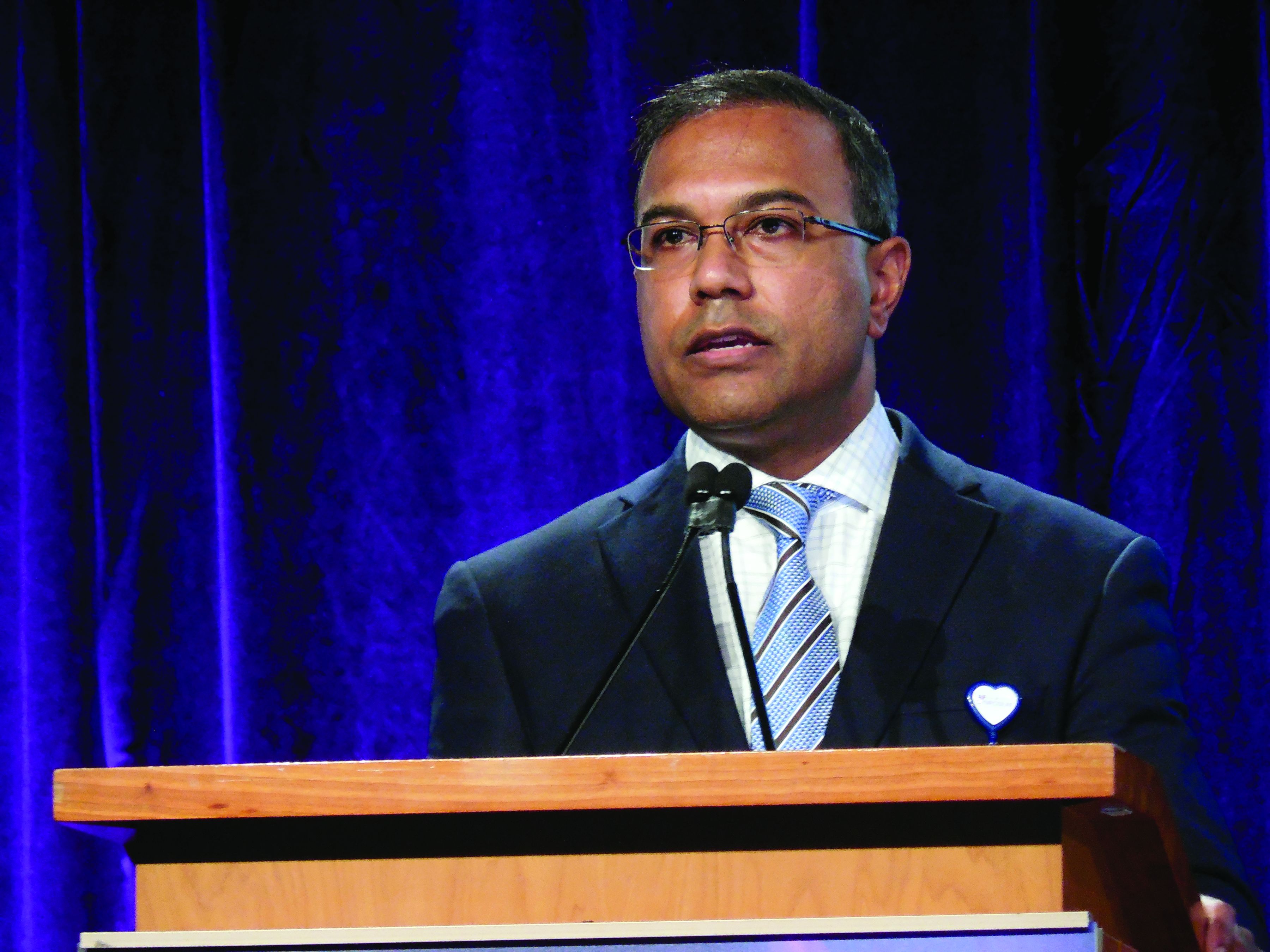User login
BOSTON – An atrial mapping catheter that combines ultrasound anatomic mapping with nontouch, high-resolution, charge-density mapping resulted in a high, 73% freedom from recurrent atrial fibrillation rate 12 months after ablation procedures guided by this catheter in a single-arm, multicenter study with 121 patients with persistent atrial fibrillation followed for 1 year.
The AcQMap device tested in the study “allows you to quickly remap” the left atrium after an initial pulmonary vein isolation or after other types of ablations to find remaining areas of abnormal electrical activity on the atrial walls and then “go after those,” Atul Verma, MD, said at the annual International AF Symposium.
An analysis he reported showed that the single patient variable that linked with the highest rate of 1-year freedom from recurrent atrial fibrillation (AF) was having at least three atrial targets ablated in addition to pulmonary vein isolation. Patients who received this number of added ablations were more than nine times more likely to be free from AF after 12 months, compared with patients who received fewer additional ablations, said Dr. Verma, a cardiac electrophysiologist at Southlake Regional Health Centre in Newmarket, Ont.
The AcQMap catheter “identifies more places to ablate.” What makes it unique among currently available mapping devices is its high resolution, its use of charge-density mapping rather than voltage-based mapping, and its speed, Dr. Verma said in an interview.
The AcQMap device has Food and Drug Administration marketing approval for mapping and so is available for routine U.S. use. However, Dr. Verma cautioned that the increased freedom from persistent AF after using the catheter during ablation that he reported should be confirmed by a randomized trial. Another electrophysiologist who performs ablations but was not involved with the study, Vivek Reddy, MD, agreed with this caveat.
“Nonrandomized trials of ablation in patients with persistent AF are at best hypothesis generating. We’ve learned that the hard way; we have been burned too many times. To assess mapping of AF activity you need a randomized, controlled trial,” said Dr. Reddy, professor of medicine and director of cardiac arrhythmia services at Mount Sinai Hospital in New York.
The UNCOVER-AF (Utilizing Novel Dipole Density Capabilities to Objectively Visualize the Etiology of Rhythms in Atrial Fibrillation) study ran at 13 centers in Canada and Europe and enrolled 129 patients who had persistent AF for an average of almost 2 years, of whom 127 actually underwent an ablation procedure and 121 were followed for 12 months post ablation. Operators were free to use the AcQMap device to map the left atrium as many times as they thought necessary, generally once at the start of the procedure, a second time after they completed pulmonary vein isolation, and then a variable number of subsequent times. On average they performed about four mappings in each patient. At entry, patients had received an average of one antiarrhythmic drug. After their ablation treatment, about 10% of patients received an antiarrhythmic drug.
The investigators found no major adverse events linked to use of the mapping device. Three patients had major adverse events related to the overall ablation procedure: Two developed cardiac tamponade, and one had a stroke. No patients had an esophageal fistula or symptomatic pulmonary vein stenosis.
After the single ablation procedure and at 12-month follow-up, the prevalence of freedom from recurrent AF was 73%, and freedom from any atrial arrhythmia was 69%. As a historical comparison, Dr. Verma cited the 12-month outcome following pulmonary vein isolation and other ablative measures in the STAR AF II (Substrate and Trigger Ablation for Reduction of Atrial Fibrillation Trial Part II) trial, which reported a 59% freedom from AF rate and a 49% freedom from any atrial arrhythmia rate with or without antiarrhythmic drug treatment after pulmonary vein isolation (N Engl J Med. 2015 May 7;372[19]:1812-22).
Multivariate analysis of the new data showed that, in addition to ablation of three or more targets, two other variables also linked significantly with long-term freedom from AF: Ablation of at least two types of electrical abnormalities in the left atrial wall, which boosted the 12-month AF-free rate by 2.8 fold, and being in sinus rhythm at the start of the ablation procedure, which linked with a 5-fold higher rate of long-term freedom from AF.
Dr. Verma also reported the AF burden measured after ablation in 96 patients who each underwent an average of 85 hours of postablation heart rhythm monitoring. Ninety percent of these patients showed no AF episodes of more than 30 seconds throughout the duration of their monitoring.
UNCOVER-AF was funded by Acutus, the company that markets the AcQMap catheter. Dr. Verma has been an advisor to or speaker on behalf of Bayer, Biosense Webster, Boehringer Ingelheim, and Medtronic, and St. Jude (Abbott), and he has received research funding from Bayer, Biosense Webster, Boehringer Ingelheim, and Medtronic. He had no personal disclosures relative to Acutus. Dr. Reddy has been a consultant to, received research funding from, and has an equity stake in Acutus, and has similar relationships with more than three dozen other companies.
BOSTON – An atrial mapping catheter that combines ultrasound anatomic mapping with nontouch, high-resolution, charge-density mapping resulted in a high, 73% freedom from recurrent atrial fibrillation rate 12 months after ablation procedures guided by this catheter in a single-arm, multicenter study with 121 patients with persistent atrial fibrillation followed for 1 year.
The AcQMap device tested in the study “allows you to quickly remap” the left atrium after an initial pulmonary vein isolation or after other types of ablations to find remaining areas of abnormal electrical activity on the atrial walls and then “go after those,” Atul Verma, MD, said at the annual International AF Symposium.
An analysis he reported showed that the single patient variable that linked with the highest rate of 1-year freedom from recurrent atrial fibrillation (AF) was having at least three atrial targets ablated in addition to pulmonary vein isolation. Patients who received this number of added ablations were more than nine times more likely to be free from AF after 12 months, compared with patients who received fewer additional ablations, said Dr. Verma, a cardiac electrophysiologist at Southlake Regional Health Centre in Newmarket, Ont.
The AcQMap catheter “identifies more places to ablate.” What makes it unique among currently available mapping devices is its high resolution, its use of charge-density mapping rather than voltage-based mapping, and its speed, Dr. Verma said in an interview.
The AcQMap device has Food and Drug Administration marketing approval for mapping and so is available for routine U.S. use. However, Dr. Verma cautioned that the increased freedom from persistent AF after using the catheter during ablation that he reported should be confirmed by a randomized trial. Another electrophysiologist who performs ablations but was not involved with the study, Vivek Reddy, MD, agreed with this caveat.
“Nonrandomized trials of ablation in patients with persistent AF are at best hypothesis generating. We’ve learned that the hard way; we have been burned too many times. To assess mapping of AF activity you need a randomized, controlled trial,” said Dr. Reddy, professor of medicine and director of cardiac arrhythmia services at Mount Sinai Hospital in New York.
The UNCOVER-AF (Utilizing Novel Dipole Density Capabilities to Objectively Visualize the Etiology of Rhythms in Atrial Fibrillation) study ran at 13 centers in Canada and Europe and enrolled 129 patients who had persistent AF for an average of almost 2 years, of whom 127 actually underwent an ablation procedure and 121 were followed for 12 months post ablation. Operators were free to use the AcQMap device to map the left atrium as many times as they thought necessary, generally once at the start of the procedure, a second time after they completed pulmonary vein isolation, and then a variable number of subsequent times. On average they performed about four mappings in each patient. At entry, patients had received an average of one antiarrhythmic drug. After their ablation treatment, about 10% of patients received an antiarrhythmic drug.
The investigators found no major adverse events linked to use of the mapping device. Three patients had major adverse events related to the overall ablation procedure: Two developed cardiac tamponade, and one had a stroke. No patients had an esophageal fistula or symptomatic pulmonary vein stenosis.
After the single ablation procedure and at 12-month follow-up, the prevalence of freedom from recurrent AF was 73%, and freedom from any atrial arrhythmia was 69%. As a historical comparison, Dr. Verma cited the 12-month outcome following pulmonary vein isolation and other ablative measures in the STAR AF II (Substrate and Trigger Ablation for Reduction of Atrial Fibrillation Trial Part II) trial, which reported a 59% freedom from AF rate and a 49% freedom from any atrial arrhythmia rate with or without antiarrhythmic drug treatment after pulmonary vein isolation (N Engl J Med. 2015 May 7;372[19]:1812-22).
Multivariate analysis of the new data showed that, in addition to ablation of three or more targets, two other variables also linked significantly with long-term freedom from AF: Ablation of at least two types of electrical abnormalities in the left atrial wall, which boosted the 12-month AF-free rate by 2.8 fold, and being in sinus rhythm at the start of the ablation procedure, which linked with a 5-fold higher rate of long-term freedom from AF.
Dr. Verma also reported the AF burden measured after ablation in 96 patients who each underwent an average of 85 hours of postablation heart rhythm monitoring. Ninety percent of these patients showed no AF episodes of more than 30 seconds throughout the duration of their monitoring.
UNCOVER-AF was funded by Acutus, the company that markets the AcQMap catheter. Dr. Verma has been an advisor to or speaker on behalf of Bayer, Biosense Webster, Boehringer Ingelheim, and Medtronic, and St. Jude (Abbott), and he has received research funding from Bayer, Biosense Webster, Boehringer Ingelheim, and Medtronic. He had no personal disclosures relative to Acutus. Dr. Reddy has been a consultant to, received research funding from, and has an equity stake in Acutus, and has similar relationships with more than three dozen other companies.
BOSTON – An atrial mapping catheter that combines ultrasound anatomic mapping with nontouch, high-resolution, charge-density mapping resulted in a high, 73% freedom from recurrent atrial fibrillation rate 12 months after ablation procedures guided by this catheter in a single-arm, multicenter study with 121 patients with persistent atrial fibrillation followed for 1 year.
The AcQMap device tested in the study “allows you to quickly remap” the left atrium after an initial pulmonary vein isolation or after other types of ablations to find remaining areas of abnormal electrical activity on the atrial walls and then “go after those,” Atul Verma, MD, said at the annual International AF Symposium.
An analysis he reported showed that the single patient variable that linked with the highest rate of 1-year freedom from recurrent atrial fibrillation (AF) was having at least three atrial targets ablated in addition to pulmonary vein isolation. Patients who received this number of added ablations were more than nine times more likely to be free from AF after 12 months, compared with patients who received fewer additional ablations, said Dr. Verma, a cardiac electrophysiologist at Southlake Regional Health Centre in Newmarket, Ont.
The AcQMap catheter “identifies more places to ablate.” What makes it unique among currently available mapping devices is its high resolution, its use of charge-density mapping rather than voltage-based mapping, and its speed, Dr. Verma said in an interview.
The AcQMap device has Food and Drug Administration marketing approval for mapping and so is available for routine U.S. use. However, Dr. Verma cautioned that the increased freedom from persistent AF after using the catheter during ablation that he reported should be confirmed by a randomized trial. Another electrophysiologist who performs ablations but was not involved with the study, Vivek Reddy, MD, agreed with this caveat.
“Nonrandomized trials of ablation in patients with persistent AF are at best hypothesis generating. We’ve learned that the hard way; we have been burned too many times. To assess mapping of AF activity you need a randomized, controlled trial,” said Dr. Reddy, professor of medicine and director of cardiac arrhythmia services at Mount Sinai Hospital in New York.
The UNCOVER-AF (Utilizing Novel Dipole Density Capabilities to Objectively Visualize the Etiology of Rhythms in Atrial Fibrillation) study ran at 13 centers in Canada and Europe and enrolled 129 patients who had persistent AF for an average of almost 2 years, of whom 127 actually underwent an ablation procedure and 121 were followed for 12 months post ablation. Operators were free to use the AcQMap device to map the left atrium as many times as they thought necessary, generally once at the start of the procedure, a second time after they completed pulmonary vein isolation, and then a variable number of subsequent times. On average they performed about four mappings in each patient. At entry, patients had received an average of one antiarrhythmic drug. After their ablation treatment, about 10% of patients received an antiarrhythmic drug.
The investigators found no major adverse events linked to use of the mapping device. Three patients had major adverse events related to the overall ablation procedure: Two developed cardiac tamponade, and one had a stroke. No patients had an esophageal fistula or symptomatic pulmonary vein stenosis.
After the single ablation procedure and at 12-month follow-up, the prevalence of freedom from recurrent AF was 73%, and freedom from any atrial arrhythmia was 69%. As a historical comparison, Dr. Verma cited the 12-month outcome following pulmonary vein isolation and other ablative measures in the STAR AF II (Substrate and Trigger Ablation for Reduction of Atrial Fibrillation Trial Part II) trial, which reported a 59% freedom from AF rate and a 49% freedom from any atrial arrhythmia rate with or without antiarrhythmic drug treatment after pulmonary vein isolation (N Engl J Med. 2015 May 7;372[19]:1812-22).
Multivariate analysis of the new data showed that, in addition to ablation of three or more targets, two other variables also linked significantly with long-term freedom from AF: Ablation of at least two types of electrical abnormalities in the left atrial wall, which boosted the 12-month AF-free rate by 2.8 fold, and being in sinus rhythm at the start of the ablation procedure, which linked with a 5-fold higher rate of long-term freedom from AF.
Dr. Verma also reported the AF burden measured after ablation in 96 patients who each underwent an average of 85 hours of postablation heart rhythm monitoring. Ninety percent of these patients showed no AF episodes of more than 30 seconds throughout the duration of their monitoring.
UNCOVER-AF was funded by Acutus, the company that markets the AcQMap catheter. Dr. Verma has been an advisor to or speaker on behalf of Bayer, Biosense Webster, Boehringer Ingelheim, and Medtronic, and St. Jude (Abbott), and he has received research funding from Bayer, Biosense Webster, Boehringer Ingelheim, and Medtronic. He had no personal disclosures relative to Acutus. Dr. Reddy has been a consultant to, received research funding from, and has an equity stake in Acutus, and has similar relationships with more than three dozen other companies.
REPORTING FROM THE AF SYMPOSIUM 2019
Key clinical point: The 1-year success of AF ablation surpassed historical controls when operators used a new mapping catheter.
Major finding: Freedom from atrial fibrillation after 1 year was 73% when operators used the AcQMap catheter during ablation procedures.
Study details: UNCOVER-AF, a single-arm, multicenter study with 121 patients with persistent atrial fibrillation ablated and followed for 12 months.
Disclosures: UNCOVER-AF was funded by Acutus, the company that markets the AcQMap catheter. Dr. Verma has been an advisor to or speaker on behalf of Bayer, Biosense Webster, Boehringer Ingelheim, and Medtronic, and St. Jude (Abbott), and he has received research funding from Bayer, Biosense Webster, Boehringer Ingelheim, and Medtronic. He had no personal disclosures relative to Acutus. Dr. Reddy has been a consultant to, received research funding from, and has an equity stake in Acutus, and has similar relationships with more than three dozen other companies.


